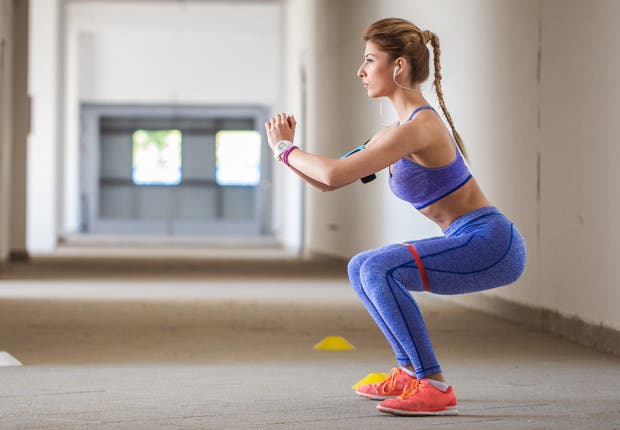Squats are among the favorite exercises of every athlete. The main reason is that they help strengthen the muscles of the lower body. Another important reason to practice them is that they reduce the risk of injury. In addition, they are one of the most useful activities to face the tasks of daily life; for example, bending down correctly to pick something up off the ground.
As the years go by, performing a series of squats can be difficult to accomplish. The primary cause is sedentary lifestyle. And those who suffer the greatest consequence are those whose work requires them to sit all day.
If you can't squat properly, you may be suffering from some muscle weaknesses or imbalances. So find out exactly what your body tells you if you can't squat .

What does your body tell you if you can't do squats?
1. You have tight hips
The main requirement to squat correctly is to get your thighs parallel to the ground. However, not having enough flexibility may be due to suffering from tight hips.
The habit of sitting for too long restricts the hip flexors to an abnormally compressed position. Over the years, your muscles become stiffer causing pain or impediment to perform full movements that require mobility of your hip.
There are hip stretches that will help you combat tension , increase flexibility, and gradually improve mobility. These are the best
1.1 Figure-Four Stretch
- With your back completely on the ground, place your left foot on your right thigh and bend your right knee.
- Gently pull the back of your right leg toward your chest.
- Hold for 30 to 60 seconds and switch sides.

1.2 Lateral quadruped stretch
- Lie on your right side
- With your legs stretched forward, bend your knees at a 90 degree angle.
- With your left hand, pull your left heel toward your left gluteal muscle.
- To intensify the stretch, engage your glutes as you pull.
- Hold for 30 to 60 seconds and then switch sides.

2. You have weak glutes and abductors
If your knees hurt when you squat , it is a consequence of a sedentary lifestyle. What usually happens is that the knees bend inward because your outer muscles are weaker than your inner muscles, causing you to exert force on your knees, causing pain and discomfort in the area.
The solution is to focus on working your glutes and outer muscles with resistance band exercises like the following.
2.1 Clamshell for adductors
- Standing, place the band just above your knees.
- Lie on your side and place your legs on top of each other and bend your knees at a 45 degree angle.
- Keeping your feet together, try to raise your upper knee as high as you can, while the other leg is always touching the ground.
- Keep your glutes tight the entire time, hold for a few seconds, and then slowly lower your knee.
- Change position and repeat.

3. You have to slow down and check your technique
Having the correct posture for squatting is more important than the speed with which you run. Therefore, make sure you are doing the exercises well before applying speed, as it is the main cause of losing your balance.
3.1 Correct squat posture
- Separate your feet to the width of your hips. Your toes and knees should always point forward.
- With your back straight, bend your knees at a 90-degree angle.
- Keep your body weight on your heels, not your toes. This will help keep you steady and stable during the movement.

conclusion
There are many factors that can prevent you from squatting correctly . The first thing to check is that you are executing it with the proper technique and posture. Later, with the guidelines provided, you can identify the other problems if you still cannot do this exercise properly.
References
- Osnato, J. Can't Do Squats? Here's What Your Body Is Trying to Tell You. For Livestrong. [Revised January 2020]
